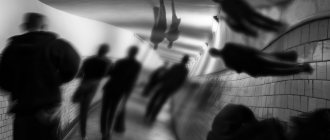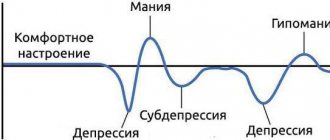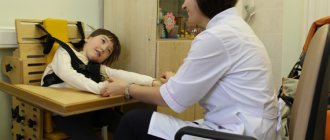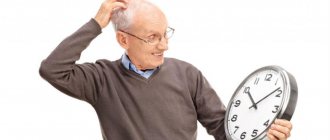Schizophrenia is one of the most complex and mysterious mental disorders. Scientists have been studying it for centuries, but have not been able to understand exactly why it occurs and whether it is possible to get rid of it forever. It occurs in approximately 1 person out of 100. The most common form of pathology is paranoid schizophrenia. In the article we will consider its main features, causes, symptoms and treatment methods.
In this article
- general characteristics
- Causes
- Symptoms
- First manifestations
- Paranoid syndrome
- Kandinsky-Clerambault syndrome
- Paraphrenic syndrome
- Schizophrenic defects
- Symptoms in women
- Symptoms in men
- Delusional and hallucinatory course
- External signs
- Diagnostics
- Treatment
general characteristics
Paranoid schizophrenia (ICD 10 classification code - F20) is also called paranoid. However, this is more a household name than a medical one. This pathology is necessarily accompanied by delusions and hallucinations. It is especially characterized by delusional disorders, which manifest themselves in various forms.
Because of this disease, a person is not able to adequately assess the surrounding reality, loses touch with reality, but at the same time retains the ability to think. During the period of remission, he is able to lead an almost normal lifestyle.
Paranoid schizophrenia is detected in approximately 1% of people. The first signs, as a rule, make themselves felt at the age of 30. Although there are other types of schizophrenia, for example, moderately progressive, which develop later. In any case, accompanying symptoms may persist for a long time. At the same time, people do not pay attention to them until the first attack, that is, the moment when it is impossible not to notice the “strangeness” in a person’s behavior.
According to statistics, 560-600 thousand cases of schizophrenia are diagnosed annually in Russia. About 85-87% of them are patients with the paranoid form. It is often detected in men. Almost all patients exhibit severe symptoms. Negative symptoms are present in 96%, delusions in 93%, chronic symptoms in 67%, verbal hallucinations in 59% of patients, and catatonic syndrome in 13% of men and 2% of women.
Causes
The main cause of paranoid schizophrenia is a functional disorder of the brain. However, there are a lot of factors that can provoke it. One of the main ones, which scientists usually call, is genetic. In simple terms, the likelihood of developing schizophrenia is higher if there is or has been a history of mental disorders in the family.
Another factor is related to the hormone dopamine. Disruption of its production causes a malfunction in certain areas of the brain, which causes delusions and hallucinations.
Doctors also name risks that could hypothetically provoke symptoms of paranoid schizophrenia:
- infectious diseases in pregnant women;
- fasting during pregnancy;
- constant stress and depression;
- psychological childhood trauma;
- drug addiction and alcoholism;
- head injuries, including birth injuries.
These factors do not always lead to schizophrenia, however, if there is a genetic predisposition, when a person has relatives with similar diagnoses, all risks, especially alcohol and drugs, should be excluded.
Causes of the disease
Scientists have not yet established the exact causes of the development of schizophrenia. However, there is a main factor that provokes the risk of this form of mental disorder with a probability of 10% to 50%. This is a hereditary predisposition. If both parents of a patient suffered from this disease, then in 50% of cases he will also develop schizophrenia. There are situations when parents act only as carriers of a “defective” gene. They pass it on to the next generation - their children or grandchildren.
Among other reasons that provoke the risk of developing the disease, scientists identify:
- consequences of past viral infections - meningitis, encephalitis, which had a detrimental effect on the functioning of the brain;
- traumatic brain, birth and perinatal injuries;
- long-term alcohol use, drug addiction;
- severe emotional stress, nervous breakdowns;
- Trauma experienced in childhood - sexual, physical or psychological abuse.
One or more of these reasons can negatively affect the functioning of the cerebral cortex, thereby causing irreversible changes in a person’s personality.
Symptoms
The symptoms of paranoid schizophrenia are as varied as any other form. Its stages can be episodic and chronic, remission can be complete or incomplete. Sometimes the disease recedes, but in other cases it develops progressively, leading to the disintegration of personality and consciousness.
The basic symptoms of any form of paranoid schizophrenia are:
- Delusions of persecution (criminal, sexual, etc.), jealousy, influence, delusions of grandeur or special purpose.
- Hallucinations of a threatening form - auditory, verbal and tactile (less often - visual).
- Attacks of senestopathy - painful sensations on the surface of the body or in the internal organs.
- Depersonalization is a psychopathological disorder of self-perception.
- Affective disorders - bipolar, depressive, inappropriate emotions, etc.
- Decreased volitional qualities, lack of initiative, lack of interest in anything.
- Cognitive impairment—memory impairment and problems formulating thoughts.
Symptoms are determined by the form and stage. First, primary symptoms are observed, which make it difficult to suspect the disease. Then delusions and hallucinations appear. After this, delusional ideas become fantastic. At the final stage of the disease, complete destruction of the personality occurs.
Paranoid schizophrenia diagnosis
At the Transfiguration Clinic Center for Psychiatry and Psychotherapy, clients will receive comprehensive medical care:
- diagnosis and detection of mental development disorders;
- determining the risk of schizophrenia;
- identifying symptoms of the disease;
- selection and prescription of optimal methods of recovery and treatment;
- determining the effectiveness of treatment;
- application of methods to prevent relapses of schizophrenia;
- the use of rehabilitation methods to return a person to a full life.
Signs and symptoms of paranoid schizophrenia
The main symptom of paranoid schizophrenia is delusion. These are persistent illogical attitudes that lead to an incorrect understanding of the world. With this mental pathology, delirium is of a mixed nature. This is also a feeling of persecution, when the patient seems to be involved in some matter for which he may be punished. Delirium of high origin: a person appropriates non-existent regalia to himself. Hypochondriacal delusions in paranoid schizophrenia are fanciful and have little connection with reality. For example, a patient claims that computers were implanted inside his body, which disrupt the functioning of his organs. In addition, delusions of love, jealousy, dysmorphophobia (non-existent physical defect) and others may occur. As the disease progresses, delirium is built into a clear, systematic chain.
Paranoid schizophrenia and delusions
Delusional disorders may be accompanied by hallucinations. This is a distortion of perception when a person perceives something that is not in the real world. The most common are auditory hallucinations: voices that only the person himself hears. They criticize the patient, argue with each other, and are threatening, forcing the person to do what he does not want. If visual hallucinations occur, the patient becomes even more disconnected from reality.
Other mental disorders in paranoid schizophrenia include:
- senestopathy - painful bodily sensations that have no physical basis;
- depersonalization – a disorder of self-perception, with alienation of one’s personality;
- social isolation and withdrawal into one’s inner world;
- emotional inadequacy, anxiety, sleep disturbances and other general mental disorders.
In paranoid schizophrenia, thinking remains intact for a long time. Negative symptoms also develop to a small extent: the will rarely suffers and emotional devastation is practically not expressed. Therefore, this group of patients maintains working capacity and commitment to socially approved actions for a long time: creating a family, having children, and others.
Most often, schizophrenia begins with auditory hallucinations, which are subsequently supplemented by visual ones. Delusion is characterized by a distorted reflection of the surrounding world, which becomes the reason for incorrect understanding of situations and a source for the development of false judgments and assessments.
First manifestations
In paranoid schizophrenia, positive symptoms are more often observed than negative ones. This means that delusions, hallucinations and thought disorders predominate, and not apathy and lack of will, as happens with other types of pathology before attacks. At the very beginning, the patient begins to have delusional ideas and thoughts. He may say that he expects something bad, scary or destructive. It happens that he is unable to calm down until, for example, he counts to 100.
Along with such thoughts, hypochondria worries me. A person is very concerned about his health and is afraid of getting sick or infected. Senestopathies often occur when there are unusual and unpleasant sensations in the body: a hoop squeezing the head, stabbing pain in the heart, as if a needle was stuck into it, etc.
At the initial stage of paranoid schizophrenia, a person’s sleep is disturbed, which affects his daytime state. His emotional background is characterized by scarcity and inflexibility, emotions are dulled. He looks like a rigid and uninterested individual who absolutely does not care what happens around him. In this case, aggression towards loved ones is possible. Your social circle is narrowing, and it becomes more difficult to establish relationships with people.
Symptoms depend on each specific case. Some patients, although few, can be violent in the initial stages. They have sadistic tendencies. They abuse animals, especially cats and dogs.
Almost all patients experience increasing fear and anxiety. Because of this, the patient turns into a confused person who cannot fully navigate the new situation. He has difficulty making decisions.
Sometimes the listed signs appear 10 or even 25 years after some injury.
This stage can continue for several years. Gradually, the number of symptoms increases as the pathology continues to progress.
Paranoid syndrome
Paranoid syndrome is the next stage of paranoid schizophrenia, which is characterized by the presence of a mild form of systematic delusions. This means that the patient can interpret and explain it well. Typical crazy ideas:
- Reformative - the patient is convinced that he has invented or created something brilliant that can change the structure of the world.
- Erotic - the conviction of the existence of a maniac who constantly pursues.
- Belief in one’s own chosenness, high origin, in belonging to the royal family or representatives of “blue blood”.
- Kverulyantskie - constant slander, filing complaints and incessantly fighting for their rights.
In paranoid syndrome, delusions are structured and systematized. The patient can logically justify arguments and provide evidence of his theories. He is not tormented by hallucinations or automatisms, so he does not consider himself sick. This aggravates the situation, since he will be met with misunderstanding from people. This will lead to depression and further development of the disease.
Stages of accepting a delusional thought:
- Expectation is an internal anxiety, a feeling that something incredible is about to happen.
- Insight - suddenly a person understands where his fear comes from, he begins to see everything differently, looks at the world with “new eyes.”
- Systematization - everything fits into one picture, which the patient can rationally explain and describe.
If the disease is detected at this stage, a diagnosis of paranoid schizophrenia will be made.
Kandinsky-Clerambault syndrome
The third stage of paranoid schizophrenia is Kandinsky-Clerambault syndrome, named after the Russian psychiatrist and French doctor. It is characterized by the development of several types of automatisms in the patient:
- Ideatorial (associative). The patient feels as if someone is putting thoughts into his head. He also suspects that others can hear his thought process. Mentism is observed - a symptom of an influx of thoughts and memories. Often the patient believes that certain events are forcing him to remember outside forces.
- Sensory (senestopathic). At this stage, automatisms concern bodily sensations. It seems to a person that they are caused from the outside. Feelings of cold, warmth or excitement, the sources of which, in fact, do not exist.
- Motor (kinesthetic). These automatisms are associated with physical activity. Now the patient believes that all his actions are performed not by him, but by someone else, as if any movement is performed without the participation of his will. This especially applies to speech motor movements.
Wizards, aliens, hypnotists, etc. can act as an extraneous force that forces a person to think, feel and act.
At this stage, if hallucinations occur, they are auditory. The patient hears swearing in his direction, comments and commands.
With Kandinsky-Clerambault syndrome, pseudohallucinations are possible, when patients distinguish hallucinations from real objects. Both familiar and unknown people, pictures, voices, etc. appear in visions.
Signs of delusion and hallucinations
The following behavioral factors may indicate the presence of auditory or visual hallucinations:
- a person talks to himself in the form of a conversation or remarks;
- at the moment when the patient becomes silent, those around him get the impression that he is listening to something. At the same time, the impression arises that he sees and hears what others do not see;
- causeless, hysterical laughter or, conversely, anxiety and concern may occur;
- During a conversation, it is difficult for the patient to concentrate on one topic.
The following signs indicate the presence of delirium:
- the individual’s attitude towards others changes sharply, unjustified hostility or isolation, alienation appears;
- statements become dubious, implausible, meaningful, and incomprehensible to others;
- a person begins to fear for his life or for the lives of loved ones; fear and anxiety are clearly manifested, which can be expressed in constantly locking doors, curtaining windows, checking food for the presence of poisons, etc.
It is necessary to react to the above behavior of the patient with the utmost restraint and delicacy. It is strictly forbidden to mock, argue with him, discuss his hallucinations, or detail them. The main thing in such a situation is to help the person feel protected, to inspire trust, and to carefully persuade them to see a doctor for advice. Relatives need to be especially vigilant towards a patient whose suicidal tendencies have worsened during the course of the disease.
Paraphrenic syndrome
Paraphrenia is the fourth stage of paranoid schizophrenia. It begins to form even at the stage of Kandinsky-Clerambault syndrome, when patients feel severe anxiety. However, subsequently the symptoms become more obvious if we talk about the perception of the patient by others.
At first, a person has pseudohallucinations and aggressive hallucinations, he is afraid of them and is constantly in a state of anxiety. But later they become friendly, and the patient feels elated. He begins to say that he has superpowers and can influence people and the world, for example, read the thoughts of others.
Unusual processes begin in memory. In particular, a person suddenly remembers an important event, which, in fact, either did not happen at all, or is slightly different from the form in which they appear to him now.
The further development of pathology is accompanied by the formation of fantastic and absurd delusions. The patient may feel like a messiah, believe that the world is divided into two hostile camps - his supporters and opponents. The following symptoms are also observed:
- False recognitions. Complete strangers seem important, as if they are taking a serious part in the patient's life.
- A feeling of euphoria, elation, a desire to move and do great things “to save the world.”
- Confabulation is the process of filling the memory with false memories that the patient cannot distinguish from true ones.
When conducting functional studies, it is discovered that a gross disruption of metabolic processes begins in the brain, as well as excessive activity of neurons in the subcortex.
Paraphrenia may be a stage of paranoid schizophrenia or a symptom of another disorder, such as bipolar or schizoaffective. In all cases, it takes two forms - acute, when symptoms develop rapidly and are well controlled, and chronic, which can occur continuously for decades.
Schizophrenic defects
With schizophrenic defects, persistent personality destruction is observed. As a rule, this can be noticed during the period of remission, when the main symptoms recede. In such cases, doctors can assess how much the personality core has been affected by the pathology.
We talk about schizophrenic defects when any 4 of the following symptoms are observed:
- Emotional coldness.
- Decreased physical activity.
- Complete lack of motivation.
- Constant silence.
- Unexpressive facial expressions.
- Indifferent attitude towards one's appearance.
Often there are symptoms of schizophasia, in which a person speaks quite clearly, but the speech does not carry any semantic load. The words the patient uses are random. The condition is similar to delusional, but at this stage classic delirium may be absent. At the last stage, the diagnosis may be changed from paranoid schizophrenia to residual schizophrenia (ICD 10 code - F20.5).
Diagnostic features
The medical doctor's examination begins with neuropsychological testing. Such a survey does not reveal specific symptoms of the disease, but they pay attention to cognitive deficits and the presence of delusional ideas.
The main role is played by collecting anamnesis and analyzing the clinical manifestations of the disease. The diagnosis is considered confirmed if the patient’s condition meets certain criteria, and all the main signs persist for at least a month. After final confirmation of paranoid schizophrenia, doctors differentiate its specific course and determine a treatment plan.
Symptoms in women
There are no significant differences between the signs of paranoid schizophrenia in women and men. However, for the former, family, health and appearance always come first, so delusional ideas are associated with this. Concern with such problems also determines the nature of hallucinations.
Women are afraid that the child will be harmed, that she is aging quickly, etc. According to her, there are ill-wishers all around. Sometimes they name specific names and surnames of real people, for example, neighbors, work colleagues or relatives.
Delusional and hallucinatory course
A number of researchers, including L.M. Elgazin and E.D. Sokolov, identifies two variants of the course of paranoid schizophrenia - hallucinatory (or pseudohallucinatory) and delusional. The first is characterized by hallucinations, but a small number of delusional ideas and the absence of automatisms. In the second case, on the contrary, delirium and automatisms are disturbing.
In this case, acute and chronic development of the pathology is possible, when symptoms develop rapidly and slowly, respectively. The acute form is characterized by anxiety, fear, confusion, unsystematized delirium and all types of automatisms.
The chronic, or continuously ongoing, type of disease is accompanied by less severe symptoms. This complicates diagnosis, since outwardly a person may not differ in any way from healthy people for a long time. Only after a few years do delusional ideas become more complex. They include more and more characters, both real and fictional.
In the hallucinatory form, primarily auditory and verbal hallucinations are observed. When they appear, the patient becomes dangerous, mainly for himself, but sometimes also for others.
Paranoid schizophrenia: symptoms and signs
The main manifestation of the disease is paranoid delusions (the correct modern name for “paranoia”) - painful, logical ideas about stalking the patient on the street and in transport, or complexly organized surveillance. Persecutors can leave symbols and codes for each other and the patient in newspapers and on TV. Gradually, the delirium becomes more complicated, and conspiracy theories emerge. The delirium includes fictitious and real structures, well-known organizations, high-ranking people who wish evil and cause damage.
Important
The disease does not allow a person to distinguish reality from pathological fantasies. A person in this state is confused, anxious and can cause harm to himself and others.
Without treatment, paranoid symptoms become more complex and completely take over the patient’s life. Hallucinations are added that confirm pathological ideas. “Voices” appear: first “calling”, and then commenting and giving orders. They can at any time order the patient to harm himself and others.
External signs
There are several signs by which relatives of a sick person may suspect he has schizophrenia:
- He is isolated from society, sees friends less often, becomes increasingly withdrawn and does not share his experiences with family members.
- A person abandons his studies, stops showing up at the university or at work.
- Gradually, he begins to take less care of himself, does not shave, rarely washes and does not monitor the condition of his clothes.
- The patient is obsessed with various kinds of ideas, is interested in mystical and religious teachings, studies paranormal topics, etc.
- The person begins to hear worse, constantly asks again or does not respond to questions.
The difficulty is that the patient does not consider himself sick, so persuading him to undergo examination is not easy. This can often be done when the symptoms become more severe.
PsyAndNeuro.ru
Response to treatment is a reduction in symptoms. Remission is the almost complete absence of symptoms, a state between response to treatment and complete recovery.
In schizophrenia, remission is possible with persistence of delusions, hallucinations, or negative symptoms. But the condition of patients in remission is, nevertheless, better than the condition outside remission. Most patients do not achieve full recovery and have residual symptoms despite taking antipsychotic medications.
The idea of RS in modern psychiatry is arbitrary and depends on the chosen point of view.
RS 1988 criteria
In 1988, criteria for defining RS were first formulated (Kane J, Honigfeld G, Singer J, et al. Clozapine for the treatment-resistant schizophrenic double-blind comparison with chlorpromazine. Arch Gen Psychiatry. 1988 Sep;45(9): 789–796):
- RS meets DSM-3 diagnostic criteria for schizophrenia.
- A minimum of three courses of different classes of antipsychotics were administered over a five-year period at doses equivalent to at least 1000 mg/day of chlorpromazine.
- Within five years it was not possible to achieve normal functioning.
- The BPRS (Brief Psychiatric Rating Scale) and CGI-S (Clinical Global Impression - Severity) scales indicate at least moderate level of psychopathology.
In addition, the investigators who formulated these criteria administered a six-week course of haloperidol 60 mg/day (a dose considered very high these days) to confirm resistance.
Criteria for RS in guidelines 2004-2016.
In seven guidelines published in 2004-2016, the criteria for RS completely coincide only with regard to the number of unsuccessful courses of treatment - there should be two. Definitions of which medications should be used vary, but most indicate that at least one of the medications used should be a second-generation antipsychotic. The duration of the course is from 2 to 8 weeks. The specific dosage is not specified in most guidelines. The severity of the condition is described in different ways: “inadequate response to treatment,” “presence of significant productive symptoms,” “lack of improvement.”
Minimum duration of antipsychotic course
The most common recommendation is to wait six weeks for a response to treatment. A 2021 meta-analysis found that those who do not respond in the first two weeks are unlikely to respond later. It is difficult to continue treatment for six weeks if there is absolutely no improvement. Therefore, 2-4 weeks are enough to understand whether there is a result or not.
RS criteria 2021
The problem is that until there is a common understanding of how to diagnose CC, comparative studies in this area are meaningless. In 2021, a group of researchers (Howes OD, McCutcheon R, Agid O, et al. Treatment-resistant schizophrenia: treatment response and resistance in psychosis (TRRIP) working group consensus guidelines on diagnosis and terminology. Am J Psychiatry. 2017 Mar 1; 174(3):216–229) proposed a minimal and optimal set of RS criteria:
- At least moderate level of symptom severity and functional impairment.
- At least a six-week course of an antipsychotic equivalent to at least 600 mg/day of chlorpromazine.
- At least two courses of treatment with different antipsychotics (not necessarily different classes).
- At least 80% adherence to treatment based on at least two sources and at least one antipsychotic blood level test.
Poor response to antipsychotics
Antipsychotics are the main drugs in the treatment of schizophrenia. However, not all patients respond equally to antipsychotics. A 2021 study found that 23% of patients never respond to antipsychotic treatment. This may be explained by the fact that MS is a specific subtype of schizophrenia. Dopamine levels are known to be elevated in patients with schizophrenia. In patients with RS, instead of increased dopamine, increased glutamate levels are found in the anterior cingulate cortex. It can be assumed that the absence of an increase in dopamine in patients with CC indicates a different biological etiology of their disease.
Duration of psychosis before treatment
It has been proven that the longer psychosis lasts before treatment, the worse the prognosis. But in the case of RS, the presence of this connection is not confirmed. But there is a connection between RS and a low level of premorbid functioning and with the onset of symptoms at an early age.
Chronic nature of the disease
With each subsequent psychotic episode, the likelihood that it will be difficult to respond to treatment increases. The time it takes for a third psychotic episode to resolve symptoms is three times longer than the first episode. The degree of deterioration of the condition directly depends on the number of relapses. Approximately one in six patients does not achieve remission after another psychotic episode. Patients with multiple episodes require a higher dose of antipsychotic medication to respond than what worked during the first episode.
Resistance can be static and dynamic. Static resistance is the absence of an early response and a poor prognosis. But there is another type of resistance - there is a response at the beginning of treatment, and resistance develops later. 30% of patients with CC responded when starting antipsychotic treatment.
In this regard, it is recommended to specify the type of resistance: early (in the first year of treatment), medium (within 1-5 years after the start of treatment), late (later than 5 years after the start of treatment). In all cases, the countdown should be carried out not from the moment the symptoms appear, but from the moment the treatment begins.
Treatment adherence problem
Lack of adherence to treatment is observed in 50% of patients with schizophrenia after discharge from hospital, 75% of patients cease to be adherent to treatment within two years after starting treatment. This is partly due to a lack of understanding of one's condition, which is a common symptom of schizophrenia (50-80% of patients). Other factors influencing adherence: medication side effects, lack of social support, medication schedule. Incomplete adherence or complete refusal of treatment is so common that it appears to be a major undetected defect in RS research.
The problem of interaction of substances
Carbamazepine, phenobarbital, phenytoin, modafinil can reduce the concentration of antipsychotics in the blood. Polycyclic aromatic hydrocarbons in cigarette smoke may enhance the metabolism of olanzapine and clozapine. Drugs such as lurasidone and ziprasidone must be taken with food, otherwise their bioavailability will be significantly reduced.
Substance use/abuse is very common in patients with schizophrenia, with levels of use being higher in RS. Half of patients with schizophrenia use alcohol and illegal substances. Depressive symptoms and quality of life are worse in those patients who frequently use drugs. Even if adherence to treatment is maintained, due to the use of illegal substances by patients, antipsychotics may not provide the expected effect. If you are not aware of the patient's substance use, you may misdiagnose RS.
Clozapine
2021 meta-review (Samara MT, Dold M, Gianatsi M, et al. Efficacy, acceptability, and tolerability of antipsychotics in treatment-resistant schizophrenia: a network meta-analysis. JAMA Psychiatry. 2021 Mar;73(3): 199–210) questioned the status of clozapine as the gold standard for the treatment of CC. However, the status of clozapine as the most effective drug for CC continues to be confirmed.
Several meta-analyses have shown that antipsychotics can be classified into three levels of effectiveness. The highest is clozapine. In the middle category - olanzapine, risperidone and amilsupride, which are superior in effectiveness to first-generation antipsychotics. At the lowest level are the remaining antipsychotics, which do not differ in effectiveness, but differ in tolerability and side effects.
There are studies in which clozapine showed worse effectiveness compared to another drug. This may be explained by the fact that clozapine was taken at suboptimal doses, particularly in studies funded by drug manufacturers.
To recognize the study as adequate, you need to know the level of the substance in the blood. There is evidence that clozapine levels should be in the range of 350-420 ng/mL to respond to treatment. A study of the effectiveness of clozapine cannot be considered adequate if its blood level does not reach the range of 350-500 ng/ml. In the range of 600-838 ng/ml, a saturation effect is observed.
Clozapine has been shown to be effective in reducing the risk of suicide in patients with schizophrenia.
Other antipsychotics
Patients with CC may be unwilling or unable to tolerate clozapine despite the benefits. When comparing the effectiveness of second-generation antipsychotics, olanzapine turned out to be the best. In RS, olanzapine has shown conflicting results. There is evidence of the effectiveness of olanzapine at a dose of 30-40 mg/day in the treatment of severe cases of schizophrenia or CC.
The effectiveness of risperidone in the treatment of CC is comparable to that of clozapine. Ziprasidone, in comparison with chlorpromazine, works better against negative symptoms in CC.
Lack of response to antipsychotic monotherapy
40-70% of patients with CC do not respond to clozapine, suggesting that 12-20% of patients with schizophrenia are ultra-resistant. In such cases, augmentation is needed. There are 42 augmentation strategies and there is no reason to recommend any one strategy as the best. The main types of augmentation involve adding a drug from another group to an antipsychotic: antidepressants, mood stabilizers, stimulants, hormones, antioxidants, antipsychotics.
Combination of antipsychotics
Although there is limited evidence for the effectiveness of antipsychotic combinations, this strategy is often used. For example, simultaneous use of a typical, atypical and depot antipsychotic.
Another strategy: adding another antipsychotic to clozapine. Studies on the effectiveness of this combination provide conflicting results.
A 2021 Cochrane review said the evidence for the effectiveness of antipsychotic combinations was “very low quality.” Basically, this conclusion is based on a comparison of clozapine monotherapy with a combination of clozapine + another antipsychotic and a comparison of monotherapy with a typical antipsychotic with a combination.
A separate Cochrane review is devoted to the treatment of CC. It draws the following conclusions from a comparison of the combination of clozapine with different antipsychotics: aripiprazole = haloperidol; amisulpride > quetiapine; sulpride = risperidone; ziprasidone = risperidone; ziprasidone > quetiapine.
Overall, the evidence for the effectiveness of antipsychotic combinations is low. Despite this, it must be borne in mind that there are subgroups of patients who may benefit from combination treatment.
Augmentation with other drugs
There is little qualitative evidence for the effectiveness of non-antipsychotic agents as augmentation agents. However, certain drugs may be useful for some subgroups of patients.
There is evidence of the effectiveness of using mood stabilizers in RS. Antidepressants can reduce negative symptoms in schizophrenia.
Summary
- Clozapine remains the best treatment for CC.
- When treating with clozapine, you should check your blood levels and wait at least 12 weeks for a response.
- If the answer is incomplete, you need to select an augmentation that is suitable for a particular patient.
Expert opinion
Recently, there is growing evidence that schizophrenia is an umbrella diagnosis that combines many biological subtypes. Neuroimaging, genetic studies, and neurotransmission studies indicate that MS may be a condition distinct from treatment-responsive schizophrenia.
Author of the translation: Filippov D.S.
Source: Justin Faden & Leslie Citrome (2019) Resistance is not futile: treatment-refractory schizophrenia – overview, evaluation and treatment, Expert Opinion on Pharmacotherapy, 20:1, 11-24
Diagnostics
Schizophrenia itself is easier to identify than its individual variety. It is necessary to conduct not one, but many examinations. The patient should almost always be under the supervision of specialists and relatives. Treatment does not stop even during periods of remission. In fact, it is completely impossible to cure schizophrenia, as well as to find out its true causes.
Direct diagnosis is carried out using the following methods:
- Neurotesting is a set of techniques and tests aimed at studying mental processes.
- Neurophysiological tests, for example, recording movements of the eyeballs to certain stimuli.
- Pathopsychological examination - consultations with a psychiatrist, psychotherapist and psychologist.
You will also have to undergo all types of tests, study the anamnesis of relatives for mental disorders, and consult with other specialists in the presence of certain somatic pathologies.
It will take time for differential diagnosis, since it is important to distinguish the paranoid form of schizophrenia from its other varieties. The decisive symptoms in order to differentiate the diagnosis are delusions, voices, delusional and unrealistic beliefs.
Most likely, the patient will have to be admitted to the clinic. In some cases, it is necessary to hospitalize a patient urgently when he poses a threat to others and himself.
Treatment
Treatment of paranoid schizophrenia is a complex process that does not stop even during remissions. After relief of all symptoms, the diagnosis remains. It is not a fact that they will ever appear, but a person remains at risk forever.
Depending on the stage of the pathology, the following types of therapy may be prescribed:
- Medication - the use of psychotropic substances, antipsychotics and antidepressants. In severe cases, insulin comatose treatment is prescribed.
- Psychotherapy - regular sessions with a psychotherapist, not only for the patient, but also for his relatives, who will have to learn how to interact correctly with a schizophrenic.
- Electroconvulsive. It is used in exceptional cases when the patient is resistant to medications or has contraindications to them. The therapy is based on exposing a person to electric current until convulsions occur. It is believed that seizures trigger certain neurochemical processes in the brain and enable short-term memory.
During the period of remission, maintenance therapy is carried out, which includes taking medications, abstaining from alcohol and periodic conversations with a psychologist. This helps prevent an attack and improve the patient’s quality of life. Sometimes it is possible to relieve him of all symptoms forever or for many years.
In general, it is important to start treatment as early as possible for schizophrenia. Then the prognosis will be relatively favorable. There is also the following pattern - the younger the age the first signs of pathology appear, the more destructive its impact on the psyche and personality.
Differential diagnosis
To correctly diagnose paranoid schizophrenia, it is necessary to exclude the possibility of developing delusional disorder, acute transient psychotic and schizoaffective disorders, dementia and other organic personality disorders.
Case history of a famous scientist
In 1958, at the age of 30, the famous mathematician John Nash showed the first signs of the disease and was diagnosed with paranoid schizophrenia. During this same period of his life, Nash made several discoveries in the field of mathematics. During his life, he was treated in psychiatric clinics several times. When the mathematician's health improved at age 34, he got a job at Princeton University.
At the age of 66, John Nash received the Nobel Prize in Economics. Thanks to John Nash's research, a new scientific approach emerged in mathematics.
The scientist learned to live with a diagnosis of paranoid schizophrenia. And this did not stop him from achieving success. His life story became the basis for the film A Beautiful Mind.
How to overcome schizophrenia?
Treatment of schizophrenia involves the use of a whole range of methods: drug treatment, psychological support, psychotherapy and social rehabilitation.
Treatment of paranoid schizophrenia
The first attack may mark the beginning of a long-term mental illness, or it may never occur again. The success of treatment largely depends on the time of detection of the disease: the earlier signs of schizophrenia are identified, the sooner treatment begins, the greater the likelihood of a positive prognosis and the higher the chances of long-term remission.
Paranoid schizophrenia is completely curable with modern means!
Anyone who wants to recover and receives the support of loved ones and caring people has every chance of curing their mental illness. According to general statistics, every fifth person in the world who suffers from schizophrenia, with the right approach to treatment, achieves long-term remission of 5 years or more. These people become full-fledged members of society and a reliable support in their family.
Research shows that if a patient participates in a special psychotherapy program, the patient’s likelihood of long-term remission increases sharply.
Treatment of paranoid schizophrenia is carried out under the supervision of a psychiatrist using medications (antipsychotics), psychotherapeutic methods under the guidance of a psychotherapist and a clinical psychologist. During treatment, the client undergoes a mandatory course of rehabilitation in the hospital and after discharge.
Prognosis in the treatment of paranoid schizophrenia
In our clinic, 90% of patients achieve a high degree of remission and can live and work on minimal doses of maintenance medications. Even when taking medications for a long time, patients can lead a normal life and realize their full potential. This requires a rehabilitation course in which the patient and his relatives participate. As statistics show, very often people who have suffered an illness can return to a busy life and become even more productive than the average person.











